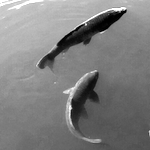Many fish species use intermittent locomotion during swimming instead of continuous propulsion. This type of swimming, called Burst and Coast, is presumed to be more energetically advantageous for fish. We are studying a new system: a propeller-driven boat that employs this bioinspired strategy to reduce its consumption. The experiment involves a boat free to move in a free surface flow and the propeller is cyclically switched on and off. We directly measure the energy consumption of the system using a dynamometer and an angular velocity sensor. By comparing the energy consumption to that of a continuously propelled boat at the same average speed, we highlight a crucial parameter of intermittent locomotion: the drag contrast between active and passive phases. In the case of fish, the drag in the active phase is approximately four times greater than in the passive phase. To replicate this phenomenon, we employ a foldable propeller capable of passively opening and closing in sync with the motor's activations. Using this type of propeller, we demonstrate that intermittent propeller propulsion can be more efficient than continuous propulsion. Under optimal conditions, at equal speeds, consumption is reduced by 24% with intermittent propulsion. We present a detailed model with a quasi-static approach that predicts consumption based on propulsion parameters (period, duty cycle, speed, etc.). This model specifically shows that there is a minimal reduction in drag for intermittent propulsion to be favorable. If the drag in the passive phase is greater than 0.4 times the drag in the active phase, continuous propulsion is more efficient.
|
|
|
|
Efficiency of intermittent locomotion
1 : Physique et mécanique des milieux hétérogenes (UMR 7636) Ecole Supérieure de Physique et de Chimie Industrielles de la Ville de Paris, Sorbonne Université, Centre National de la Recherche Scientifique, Université Paris Cité, Centre National de la Recherche Scientifique : UMR7636
|

 PDF version
PDF version
